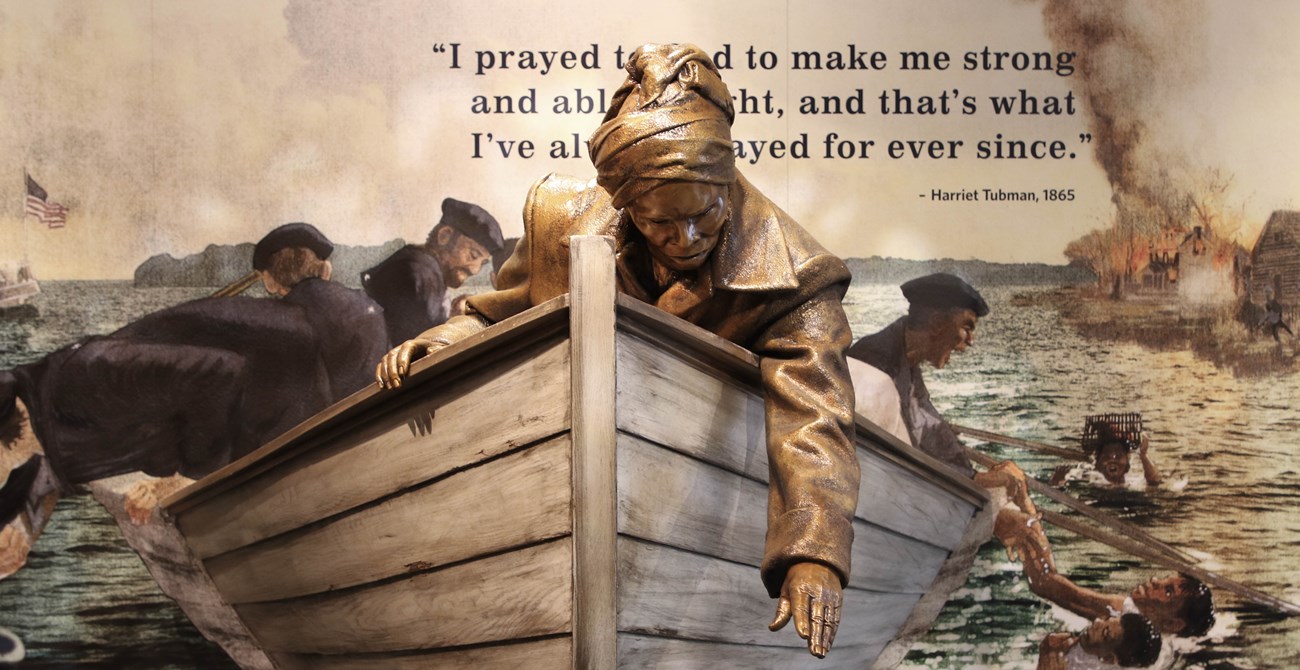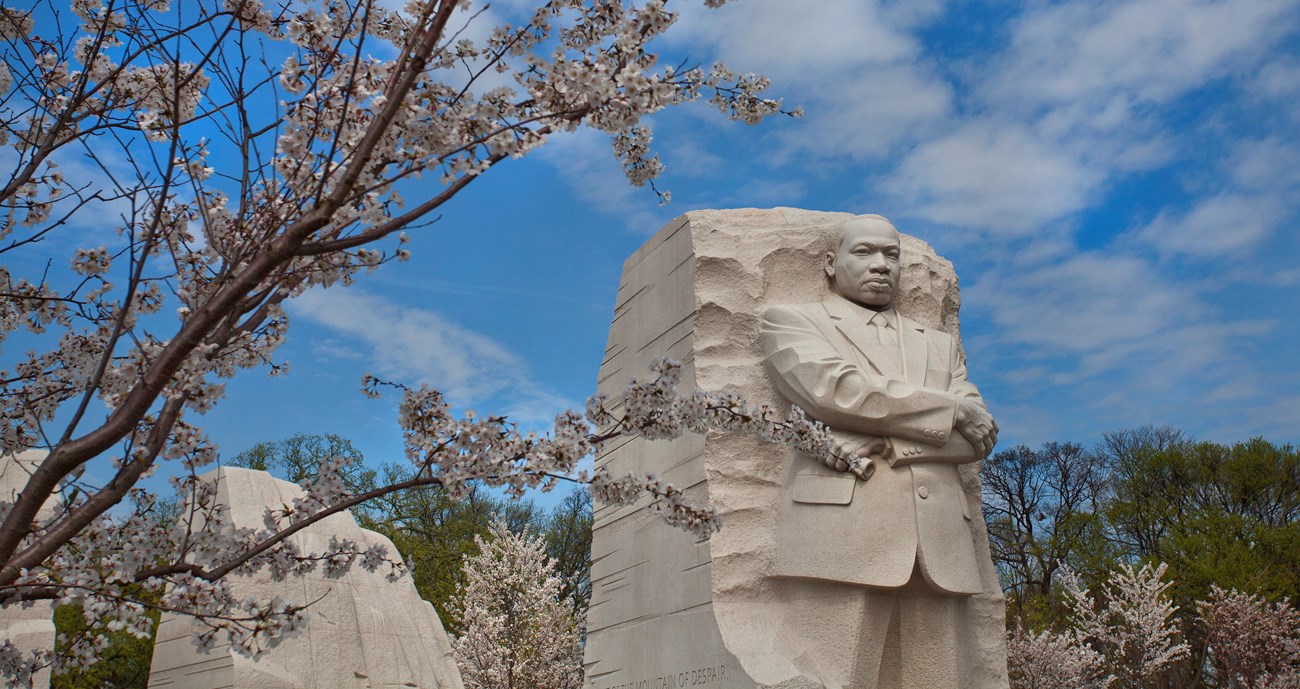Last updated: March 2, 2021
Article
National Parks Named in Honor of African Americans
There are more than 400 national parks across the country of different shapes, sizes, naming designations, and reasons for being created as parks. African American history is preserved and shared in many national parks with some being created as monuments to remember specific individuals in our nation's history. Explore national parks that were named after people and visit their websites to take a deeper look at their life's achievements, contributions, and lasting legacies.

NPS Photo
Booker T. Washington National Monument, Virginia
Booker T. Washington National Monument commemorates the life and legacy of one of America’s most prominent educators and orators of the late 19th and early 20th centuries. Born into enslavement on small tobacco farm in 1856, Booker T. Washington (1856-1915) became a nationally-respected author, orator, and adviser to US presidents. Believing strongly in education, he built Tuskegee Institute to give more quality higher education opportunities to African Americans in the South at a time when options were extremely limited.

NPS Photo
Carter G. Woodson Home National Historic Site, District of Columbia
Known as the “Father of Black History,” Dr. Carter G. Woodson (1875-1950) committed his life to institutionalizing the field of Black History as an academic and scientific field. He created “Negro History Week” (now Black History Month) in 1926 to help formalize Black History as part of school curriculums. The Carter G. Woodson Home National Historic Site in Washington, DC was his longtime home and headquarters for what is now known as the Association for the Study of African American Life and History (ASALH), which he co-founded.

NPS Photo
Charles Young Buffalo Soldiers National Monument, Ohio
A two-story home in the peaceful fields of southwestern Ohio is now Charles Young Buffalo Soldiers National Monument, which honors the legacy of the legendary all-Black US Army regiments known as the “Buffalo Soldiers” and one of their most distinguished leaders. Charles Young (1864-1922) was a soldier, diplomat, and civil rights leader overcoming stifling inequality throughout his career and lifetime. In 1903, Captain Young became the first African American national park superintendent when he and his command of Buffalo soldiers were tasked with protecting Sequoia and General Grant (now Kings Canyon) national parks.

NPS Photo
Frederick Douglass National Historic Site, District of Columbia
On a hill overlooking the US Capitol is Frederick Douglass National Historic Site, where one of American history’s most famous civil rights activists lived the last 17 years of his life. Born into slavery in 1818, Frederick Douglass (1818-1895) escaped his enslavement and became a national leader in the abolitionist movement giving powerful speeches and publishing several autobiographies still widely read today. With a firm belief of the equality of all peoples, Douglass championed civil rights, justice, and better opportunities for many groups of Americans.

NPS Photo
George Washington Carver National Monument, Missouri
Not just the “Peanut Man,” George Washington Carver (1864-1943) was one of America’s great agricultural scientists, educators, environmentalist, and humanitarians. George Washington Carver National Monument reveals how growing up on a small farm surrounded by nature and nurture greatly influenced Carver in his quest for education. his resourcefulness, and his skill as an agriculturalist. While a professor at the famous Tuskegee Institute, Carter developed agricultural techniques to improve the lives of lower income farmers in the country.

NPS Photo
Harriet Tubman National Historic Site, New York
Harriet Tubman National Historic Site in New York preserves the last home of a woman who achieved legendary status during her lifetime. Born into slavery, Harriet Tubman (1822-1913) secured her own freedom and for many others as one of the most famous “conductors” on the Underground Railroad. During the Civil War, she served as a spy, scout, nurse, and cook for the US Army, even leading a raid to rescue more than 700 enslaved people. While living in New York after the Civil War, Tubman gave much of her own resources to improving the lives of others, including establishing the Harriet Tubman Home for Aged & Indigent Negroes.

NPS Photo
Harriet Tubman Underground Railroad National Historical Park, Maryland
Harriet Tubman Underground Railroad National Historical Park is where an American legend began. Born Araminta Ross in Maryland’s Eastern Shore, Tubman resisted her enslavement from an early age and ultimately escaped alone and on her own in 1849. She returned to the Eastern Shore at least 13 times and freed more than 70 people trying to keep family and friends from being separated due to enslavement. Tubman went on to aid the US Army during the Civil War and continued to advocate for the rights African Americans, women, and Americans with disabilities after the war.

NPS Photo
Maggie L. Walker National Historic Site, Virginia
Maggie Lena Walker (1864-1934) grew up in post-Civil War Virginia during a time of "Jim Crow" laws. Despite adversity and obstacles, Walker became a became a prominent businesswoman and community leader by founding a bank, serving as a bank president, newspaper editor, and fraternal leader, and fostering entrepreneurialism in the African American community. Maggie L. Walker National Historic Site explores her life, which was dedicated to defeating racism, sexism, and economic oppression.

NPS Photo
Martin Luther King, Jr. Memorial, District of Columbia
Among the national monuments that part of the National Mall and Memorial Parks in the heart of the nation’s capital stands the Martin Luther King, Jr. Memorial. Dr. Martin Luther King Jr. (1929-1968) was internationally known during his life as a prominent leader of the Civil Rights Movement and for working tirelessly as an advocate for racial equality, working class, and oppressed around the world. His memorial is in sight of the Lincoln Memorial where he delivered his inspiring “I Have a Dream” speech in 1963 during the March on Washington for Jobs and Freedom.

NPS Photo
Martin Luther King, Jr. National Historical Park, Georgia
Martin Luther King, Jr. National Historical Park in Atlanta is where the journey of the world-renown civil rights advocate began. The park gives a closer look at the life of Dr. Martin Luther King, Jr. through the home of his birth and the community where he grew up in a time of racial prejudices and legalized segregation. He followed in his father’s footsteps becoming both a minister and civil rights advocate, then ultimately becoming a national leader preaching advancing civil rights through nonviolence and civil disobedience.

NPS Photo
Mary McLeod Bethune Council House National Historic Site, District of Columbia
Nestled in a row of townhouses within walking distance of the White House, Mary McLeod Bethune Council House National Historic Site honors the legacy of Mary McLeod Bethune (1875-1955). With a very extensive resume of work, Bethune used the power of education, political activism, and civil service to achieve racial and gender equality throughout the United States and the world. Located only a few blocks from the home of her friend and colleague Dr. Carter G. Woodson, her home also served as the first headquarters of the National Council of Negro Women and housed the National Archives for Black Women’s History.

NPS Photo
Medgar and Myrlie Evers Home National Monument, Mississippi
Medgar and Myrlie Evers Home National Monument is one of the newest additions to the National Park System. Medgar Evers (1925-1963), Myrlie Evers (born 1933), and their three young children lived in the home when the couple were involved in the Civil Rights Movement, which included Medgar Evers being the public face of the National Association for the Advancement of Colored People (NAACP) in Mississippi. The tragic assassination of Medgar Evers in 1963 for his efforts to promote racial equality and social justice was one of the key catalysts for passage of the Civil Rights Act of 1964 as the nation reacted in horror to his death.
